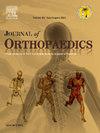近端腓骨截骨明确改善内侧室膝骨关节炎:有限元分析
IF 1.5
Q3 ORTHOPEDICS
引用次数: 0
摘要
目的探讨腓骨近端截骨术(PFO)对内侧室膝关节骨性关节炎(KOA)的生物力学影响。此外,本研究利用有限元分析(FEA)来研究术前和术后PFO对内侧室KOA的生物力学影响。方法随机选取15例内侧室KOA患者。采用三维重建软件,结合有限元分析软件对PFO进行建模,观察PFO前后股骨软骨、胫骨平台软骨、半月板关节软骨的应力分布、峰值应力和接触面积的变化。结果PFO术后膝关节(KJ)峰值应力及应力分布发生显著变化。应力分布明显由内侧向外侧转移。股骨内侧软骨(从1.91±0.44降至1.40±0.14)、内侧半月板(从2.89±0.72降至2.05±0.49)、胫骨平台内侧软骨(从2.25±0.65降至1.60±0.38)的峰值明显降低。相反,这些指标在股骨外侧软骨(从1.10±0.32增加到1.59±0.30),外侧半月板(从1.82±0.58增加到2.49±0.60)和胫骨外侧平台软骨(从0.95±0.21增加到1.40±0.26)中有所增加。关节软骨应力分布面积在内侧明显减小(346.25±55.66 ~ 267.05±51.05),在外侧明显增大(219.35±38.89 ~ 333.25±29.90)。结论pfo可有效减轻KJ内侧室的压力,为治疗内侧室KOA提供了一种简单有效的方法。本文章由计算机程序翻译,如有差异,请以英文原文为准。
Proximal fibular osteotomy definitively ameliorates medial compartment knee osteoarthritis: A finite element analysis
Objective
This study was designed to explore the biomechanical impacts of the proximal fibular osteotomy (PFO) on medial compartment knee osteoarthritis (KOA). Furthermore, this study utilized finite element analysis (FEA) to examine the biomechanical impacts of PFO on medial compartment KOA both pre- and post-surgery.
Methods
Fifteen individuals with medial compartment KOA were selected randomly. Three-dimensional reconstruction software, coupled with FEA software, was employed to model PFO, allowing observation of changes in stress distribution, peak stress, and contact area of articular cartilage in femoral cartilage, tibial plateau cartilage, and meniscus before and after PFO.
Results
After PFO, significant changes in peak stress and stress distribution in the knee joint (KJ) were observed. The stress distribution shifts notably from the medial side to the lateral side. A significant reduction in peak values was observed in the medial femoral cartilage (changing from 1.91 ± 0.44 to 1.40 ± 0.14), medial meniscus (2.89 ± 0.72 to 2.05 ± 0.49), and medial tibial plateau cartilage (2.25 ± 0.65 to 1.60 ± 0.38). On the contrary, an increase in these metrics was recorded in the lateral femoral cartilage (changing from 1.10 ± 0.32 to 1.59 ± 0.30), lateral meniscus (1.82 ± 0.58 to 2.49 ± 0.60), and lateral tibial plateau cartilage (0.95 ± 0.21 to 1.40 ± 0.26). In addition, the stress distribution area of articular cartilage was reduced significantly in the medial dimension (346.25 ± 55.66 to 267.05 ± 51.05) and increased in the lateral dimension (219.35 ± 38.89 to 333.25 ± 29.90).
Conclusion
PFO demonstrates effectiveness in alleviating stress within the medial compartment of the KJ, presenting a straightforward and efficacious approach for managing medial compartment KOA.
求助全文
通过发布文献求助,成功后即可免费获取论文全文。
去求助
来源期刊

Journal of orthopaedics
ORTHOPEDICS-
CiteScore
3.50
自引率
6.70%
发文量
202
审稿时长
56 days
期刊介绍:
Journal of Orthopaedics aims to be a leading journal in orthopaedics and contribute towards the improvement of quality of orthopedic health care. The journal publishes original research work and review articles related to different aspects of orthopaedics including Arthroplasty, Arthroscopy, Sports Medicine, Trauma, Spine and Spinal deformities, Pediatric orthopaedics, limb reconstruction procedures, hand surgery, and orthopaedic oncology. It also publishes articles on continuing education, health-related information, case reports and letters to the editor. It is requested to note that the journal has an international readership and all submissions should be aimed at specifying something about the setting in which the work was conducted. Authors must also provide any specific reasons for the research and also provide an elaborate description of the results.
 求助内容:
求助内容: 应助结果提醒方式:
应助结果提醒方式:


